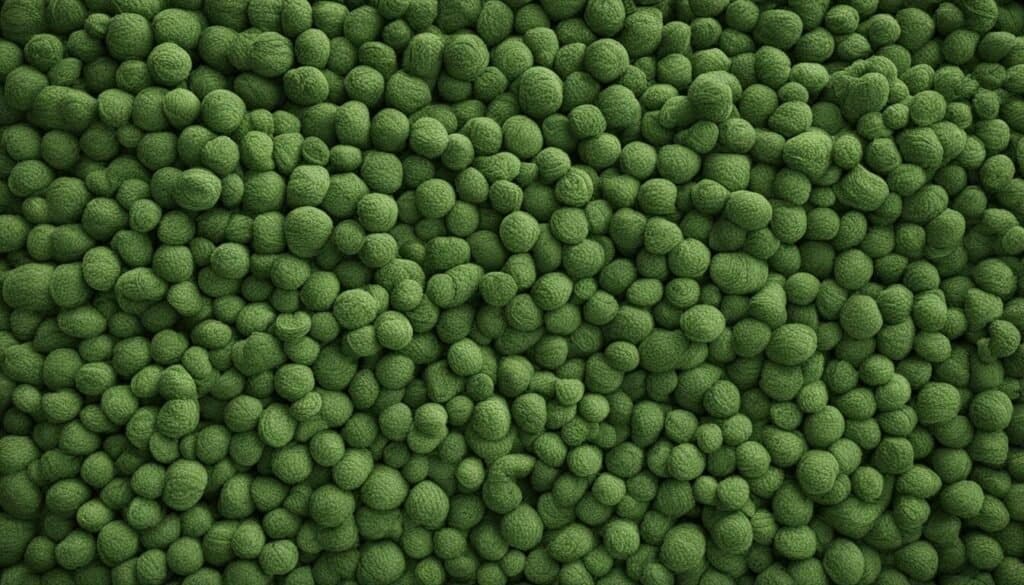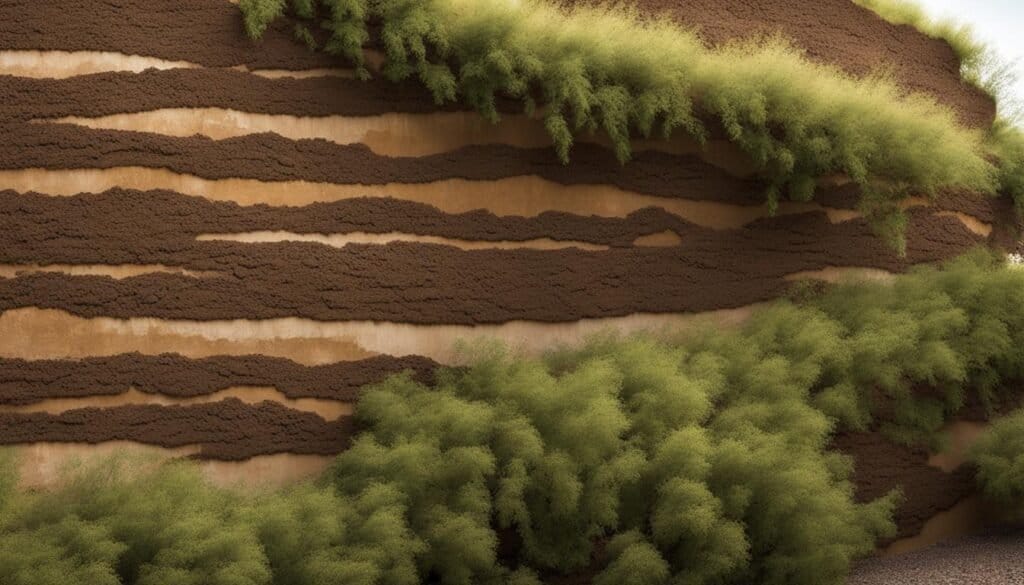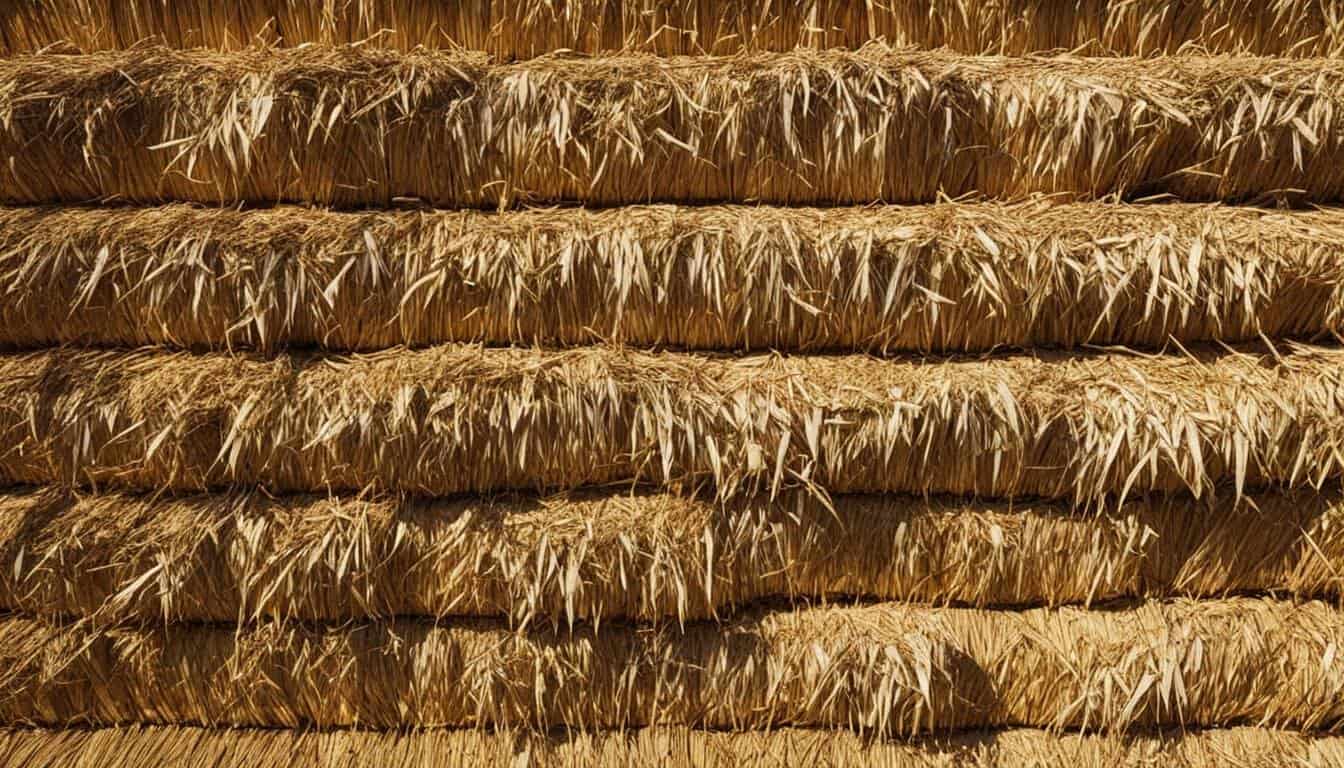As our world shifts towards environmentally sustainable practices, homeowners and builders alike are seeking ways to increase energy efficiency and reduce environmental impact. I recently embarked on a research journey to uncover the most eco-friendly insulation alternatives that not only offer superb energy bill savings but also promote a sustainable home build.
The result is this comprehensive guide highlighting nine innovative and green building materials for insulation that cater to various budgets, design preferences, and eco-conscious construction goals.
Key Takeaways
- Green building materials for insulation prioritize energy efficiency and environmental sustainability.
- Eco-friendly insulation alternatives encompass a variety of traditional and innovative materials.
- Green home insulation lowers energy costs and helps reduce your carbon footprint.
- Both natural and recycled materials can be excellent choices for sustainable insulation.
- Eco-conscious construction strives for more than just meeting minimum code requirements, aiming to maximize energy savings and promote environmental sustainability.
Top 9 Green Building Insulation Materials
Some of the most popular insulations you will see on the market in 2024 and beyond as we focus on sustainability:
- Cellulose insulation
- Comprised of 75-85% recycled paper content
- R-value of 3.5-3.8 per inch
- Uses 8 times less energy to manufacture than fiberglass insulation
- Can reduce air infiltration by up to 50% compared to fiberglass
- Fiberglass insulation
- Comprised of 20-30% recycled glass content
- R-value of 2.2-2.7 per inch for blown-in fiberglass
- Expected to have 52% market share of insulation materials in 2024
- Has an estimated lifespan of 10-15 years
- Spray foam insulation
- Closed cell spray foam has an R-value of 5.5-6.5 per inch
- Can reduce energy usage by 40-70%
- Estimated to grow at a CAGR of 6.4% from 2021-2027
- Offers high resistance to moisture and air infiltration
- Mineral wool insulation
- Comprised of 75% post-industrial recycled content
- Does not require chemical flame retardants
- R-value of 4-4.5 per inch
- Sheep’s wool insulation
- Comprised of rapidly renewable natural fibers
- Excellent thermal insulator due to wool’s structure
- Must use large quantities to insulate entire buildings
- Hempcrete
- Comprised of hemp hurds and lime
- R-value of 0.5-1 per inch
- Breathable and moisture regulating
- Cork insulation
- Made from renewable harvested bark
- R-value of about 4 per inch
- Waterproof and rot resistant
- Denim insulation
- Uses recycled cotton from old denim jeans
- R-value of 3.5-4 per inch
- Excellent acoustic insulator
- Straw bale insulation
- Made from waste agriculture straw
- R-value of about R-30 for a full bale
- Provides good thermal mass
Why Insulation is Crucial in Eco-Friendly Construction
Insulation is the foundation of energy efficiency in any building project, playing a pivotal role in regulating indoor temperatures and reducing energy consumption. Selecting the right insulation material for your green building involves considering several factors such as thermal resistance, environmental impact, safety, installation difficulty, and cost-effectiveness.
Understanding R-Value and Thermal Resistance
R-value is a measure of a material’s thermal resistance, indicating its ability to insulate. A higher R-value means better insulation properties, which contribute to reduced energy consumption and increased energy savings. However, it is essential to recognize that a high R-value is only one factor to consider when choosing eco-friendly insulation materials for your home construction.
The Role of Insulation in Energy Efficiency
Effective insulation is crucial in minimizing energy waste and reducing a building’s overall energy consumption. By selecting high-quality insulation materials for your green building, you will not only contribute to combatting climate change but also lower your energy bills. Thermal insulation can help keep your home warm in the winter and cool in the summer, enhancing your living environment and increasing energy savings.
Balancing Cost and Environmental Impact
While a high R-value is undeniably important, eco-friendly construction requires a balance between cost and long-term sustainability. This includes considering each insulation material’s safety, installation difficulty, and cost-effectiveness. Choosing materials that promote energy savings and eco-friendliness contributes to minimizing your home’s environmental impact and supports a sustainable construction industry.
In conclusion, insulation serves a crucial role in the realm of eco-friendly home construction. Understanding the R-value of insulation materials and recognizing the importance of energy efficiency, as well as balancing cost and environmental impact, will enable you to make informed choices when selecting insulation materials for your green building project.
The Warmth of History: Reclaimed Wood Insulation
When it comes to eco-friendly insulation material, reclaimed wood insulation stands out as an exceptional choice. By repurposing old wood from structurally sound sources such as deconstructed buildings and barns, the demand for freshly harvested timber is reduced. This leads to a decrease in deforestation and ultimately results in a lower carbon footprint. The incorporation of reclaimed wood in green building projects not only supports environmental sustainability, but also adds unique character and historical depth to homes.
Green Building Alliance: When insulating a home, it’s important to use both a thermal barrier and an air barrier, as air flowing through or around insulation is one of the biggest causes of energy waste.
Sustainability is a crucial aspect of green building, and using reclaimed wood insulation directly addresses the issue of deforestation. By decreasing the demand for new timber, we help to preserve forests and reduce the negative environmental impact of logging. The use of reclaimed wood insulation is a practical way to promote responsible resource consumption in the construction and renovation of buildings.
Reclaimed wood insulation breathes new life into old wood and supports environmental values while adding unique character to homes.
Reducing one’s carbon footprint is an essential element in the fight against climate change. Reclaimed wood insulation helps achieve this goal by cutting down the need for newly harvested materials. As a result, the construction and renovation process of eco-friendly buildings greatly reduces the overall environmental impact and supports a greener lifestyle.
- Reclaimed wood: Sourced from old wood without harming forests.
- Lower carbon footprint: Using reclaimed wood minimizes the need for new timber in construction.
- Deforestation reduction: Decreased demand for fresh timber leads to less deforestation.
- Unique character: Reclaimed wood adds a sense of history and depth to homes.
- Eco-friendly building material: Incorporating reclaimed wood in green building projects promotes environmental values.
In conclusion, reclaimed wood insulation is an eco-friendly material that greatly contributes to the sustainability, beauty, and carbon footprint reduction of green buildings. By repurposing existing wood, we help to protect forests, decrease deforestation, and promote a more sustainable future in construction. Reclaimed wood insulation is an excellent choice for those looking to embrace green building practices and reduce their impact on the environment.
Straw Bales: From Agricultural Byproduct to Insulation Marvel
Straw bales have long been recognized as a waste product in the agricultural world, but now they’re gaining popularity as an excellent insulation material for eco-friendly construction. These humble bales boast impressive thermal insulation properties, cost-effectiveness, and sustainability, which make them an ideal choice for green builders seeking high R-value insulation options.
High R-Value and Fire Resistance
Straw bales offer remarkable thermal insulation, thanks to their high R-value, which is a measure of a material’s ability to resist heat transfer. As a result, buildings insulated with straw bales maintain a comfortable temperature with minimal energy use. Surprisingly, straw bales are also known for their inherent fire resistance. When packed tightly, the dense bales smother the oxygen needed for combustion, providing a natural fire barrier within walls.
Cost-Effectiveness and Sustainability Strengths
As an agricultural byproduct that’s typically discarded, straw bales are not only a renewable resource but also a cost-effective insulation alternative. Sourcing straw bales from local farmers not only supports the local economy, but also reduces transportation costs and emissions. This innovative use of agricultural waste as an energy-efficient insulation material represents a significant step forward in sustainable building practices.
In conclusion, using straw bales as an insulation material is an innovative and eco-friendly approach to sustainable construction. With their superb thermal insulation properties, high R-value, fire resistance, and cost-effectiveness, straw bales have evolved from a simple agricultural byproduct to an insulation marvel that is well-suited for green builders.
Exploring Bamboo’s Versatility: A Rapidly Renewable Insulation
One of the remarkable characteristics of bamboo is its rapid growth, which makes it an excellent choice for sustainable construction. As an eco-friendly building material, bamboo typically reaches full maturity within just three to five years, significantly faster than conventional woods. This speed provides a distinct advantage to builders seeking a renewable resource for their building supplies, particularly when it comes to insulation.
As a green insulation option, bamboo is versatile and sustainable. Due to its quick maturation cycle, it creates less impact on forests and local ecosystems, minimizing habitat loss and supporting responsible construction practices. With bamboo insulation, builders and homeowners can achieve the thermal performance and sustainability their designs demand.
Utilizing bamboo in construction aligns with green building principles and encourages the market for sustainable building supplies. By choosing bamboo and other similar materials, we contribute to a growing movement toward more environmentally-friendly and forward-thinking construction methods that truly make a difference for our planet.
Bamboo’s strength and rapid turnover make it an attractive option for those looking to minimize their environmental footprint and build sustainably.
As more people embrace sustainable construction methods, we can expect bamboo to become an increasingly popular choice for insulation and other building applications. Its versatility, renewable nature, and exceptional growth rate make it a standout amongst other green insulation options, reinforcing our commitment to environmental stewardship and fostering a greener, more sustainable future.
Hempcrete: An Innovative and Carbon-Negative Insulator

Leading the charge in sustainable building materials is hempcrete, a groundbreaking solution that combines the best of eco-friendly elements with impressive insulation properties. Focused on providing an innovative and carbon-negative insulation performance, hempcrete is changing the game in green construction and sustainable building.
Benefits of Building with Hempcrete
Hempcrete is a unique and remarkable substance, created by mixing hemp fibers with lime and water. It results in a lightweight, breathable, and highly insulating material, perfect for wall construction and insulation in both residential and commercial settings.
The carbon-absorption capabilities of hemp, obtained during its growth phase, contribute to reducing the overall carbon footprint of buildings that use hempcrete as an insulation material. This innovative product offers some distinctive advantages:
- Energy bill reductions: Hempcrete’s insulating properties help maintain comfortable indoor temperatures, leading to significant energy savings for homeowners and building occupants.
- Carbon-negative: As the hemp plant grows, it absorbs carbon dioxide from the atmosphere, making hempcrete a carbon-negative building material.
- Mold and pest resistance: Hempcrete is naturally resistant to mold, mildew, and pests, ensuring longevity and low maintenance costs.
Hemp’s Role in Green Construction
As the demand for eco-friendly insulation material continues to increase, hempcrete is becoming a vital component in sustainable building practices. It exhibits superior performance among various insulation types and has the added benefit of being environmentally responsible. By using hempcrete, builders and homeowners demonstrate their commitment to energy efficiency, carbon sequestration, and reduced reliance on traditional construction materials.
With its innovative insulation qualities and carbon-negative nature, hempcrete is firmly establishing itself as a top choice for sustainable building projects. Its widespread adoption has the potential to drive significant advancements in green construction, putting forth a strong example for the industry to follow and adopt newer and better insulation solutions.
Solid Strength: Recycled Steel

Recycled steel is steadily gaining attention as a sustainable insulation reinforcement material. With its durability, strength, and environmental benefits, it offers a smart alternative to virgin steel and traditional insulation choices. This section discusses the energy savings in steel recycling and the durability and eco-friendliness of using recycled steel in building insulation.
Energy Savings in Steel Recycling
Recycled steel is an incredibly sustainable material for several reasons, including its potential for substantial energy savings. Compared to producing virgin steel from raw materials, steel recycling uses significantly less energy, resulting in a lower carbon footprint and improved sustainability. Additionally, using recycled steel reduces the need for raw-material mining and deforestation, further minimizing the environmental impact of construction projects.
The Durability and Eco-Friendliness of Steel
Not only does recycled steel share the same strength and durability of virgin steel, but it also contributes positively to green building efforts. Top metal roof suppliers and construction professionals increasingly embrace recycled steel as a key component for insulation reinforcement. By choosing steel with a high recycled content, builders can minimize the ecological impacts of construction and create energy-efficient structures. Moreover, steel is highly durable and resistant to wear and tear, ensuring its value as a long-lasting insulation choice for any green building.
In conclusion, recycled steel offers immense benefits in terms of energy savings, durability, and eco-friendliness. Embracing this sustainable insulation material helps reduce energy consumption, raw material mining, and carbon emissions in the construction industry. Therefore, selecting recycled steel as a building insulation material contributes significantly to the global shift toward sustainable and environmentally conscious construction practices.
Green Building Materials for Insulation

The movement toward utilizing green building materials for insulation has led to a wealth of eco-friendly alternatives. These alternatives enable homeowners and builders to lessen their reliance on non-renewable materials while offering superior advantages in terms of energy efficiency, environmental impact, and sustainable insulation of homes.
Eco-Friendly Insulation Alternatives
There is a broad range of green insulation options available for homeowners who wish to build or renovate with sustainability in mind. These options include both natural and renewable resources, such as sheep’s wool and cotton, as well as recycled materials like denim and newspaper. Embracing these alternatives not only reduces our dependency on non-renewable materials but also proves to be more environmentally friendly and energy-efficient.
The Advantages of Green Insulation Materials
Choosing green insulation options comes with numerous advantages, especially in terms of sustainability and energy efficiency. Natural materials such as sheep’s wool are renewable and have a low environmental impact compared to traditional insulation. In addition, many eco-conscious insulation options, such as recycled denim, are sourced from post-consumer waste, reducing the amount of waste going to landfills.
Eco Peanut: Sheep’s wool is a natural, non-toxic insulation option that absorbs moisture and turns it into heat, also helping to filter out chemicals from the air and improving indoor air quality.
Green insulation materials also contribute to the construction of energy-efficient homes, enabling homeowners and businesses to reduce their energy consumption and resulting utility bills. Moreover, many eco-friendly insulation alternatives boast excellent thermal properties that ensure comfortable living spaces while reducing the resources needed to maintain a constant temperature throughout an environmentally sustainable structure.
The Timeless Allure of Rammed Earth as Insulation

One of humanity’s most ancient and fascinating building techniques is rammed earth construction. It boasts a robust blend of beauty and sustainability, incorporating the use of local materials and traditional techniques for a natural building method. This eco-friendly insulation choice has stood the test of time, proving its worth in both green building and energy efficiency.
Rammed earth is a sustainable construction method that leverages a mixture of clay, sand, gravel, and lime. This combination creates structures with formidable thermal mass, providing excellent insulation properties that significantly reduce energy consumption. Its captivating aesthetics and seamless integration with the environment make it an ideal choice for eco-conscious homeowners seeking a sustainable living space.
“Rammed earth offers not only environmental benefits but also enables the creation of unique, energy-efficient homes that reflect our commitment to a greener future.”
Key benefits of rammed earth as an insulation material include:
- High thermal mass
- Use of local, natural materials
- Minimal embodied energy
- No off-gassing of harmful chemicals
- Low maintenance requirements
Many architects and builders are rediscovering the allure of rammed earth and embracing it in modern construction projects. This ancient technique is now gaining popularity among those who wish to minimize their environmental impact and improve the energy efficiency of their homes.
By utilizing local resources, rammed earth construction leads to a significant reduction in the need for transportation and manufacturing of synthetic materials. This results in a lower carbon footprint, making it an excellent choice for green building enthusiasts.
In conclusion, the timeless beauty and eco-friendly benefits of rammed earth insulation make it a compelling option for sustainable homeowners. By selecting this natural building method, you can actively contribute to the green building movement, ensuring a healthier environment for generations to come.
Cork: An Eco-Friendly Insulator with Unique Qualities
As a sustainable insulation material, cork offers unparalleled benefits due to its renewable nature and impressive properties. Harvested from the outer bark of cork oak trees without harming them, cork serves as a resilient and eco-friendly construction material. Its remarkable thermal and acoustic insulating attributes, combined with mold and mildew resistance, make it an effective insulator that enhances energy efficiency in buildings.
In addition to insulation, cork’s versatility makes it a popular choice for flooring and wall coverings. Embracing cork as an eco-friendly building material aligns perfectly with the growing trend of green construction and sustainable living.
Renewable, Resilient, and Energy Efficient
One of the key advantages of cork insulation is its sustainability, derived from being a renewable resource. Since the cork oak trees remain unharmed during bark harvesting, they continue to grow and regenerate more cork. Moreover, cork forests support a unique ecosystem, fostering biodiversity and reducing greenhouse gas emissions.
Apart from its environmental benefits, cork boasts resilience, which is vital for insulation longevity. It can compress, flex, and regain its original shape over time, resulting in enhanced durability and minimal deterioration of insulation performance.
Lastly, cork exhibits excellent energy efficiency, helping homeowners save on energy bills while reducing their ecological footprint. Its natural insulating properties contribute to maintaining comfortable indoor temperatures and lowering energy usage.
Improving Acoustic and Thermal Performance
Cork is a standout material for its ability to enhance both acoustic and thermal performance in buildings. The cellular structure of cork consists of tiny, sealed air pockets that effectively minimize heat transfer and dampen sound. This allows cork insulation to regulate indoor temperatures and reduce noise levels, creating comfortable living spaces.
Due to the advantages it offers, cork insulation is increasingly gaining traction within the green construction industry. By opting for this eco-friendly, renewable, and resilient material, homeowners can create energy-efficient, comfortable, and environmentally responsible homes.
The Energy-Producing Insulator: Solar Tiles
Solar tiles represent a transformative convergence of insulation and renewable energy generation. These innovative roofing materials integrate solar cells with energy-producing insulation, creating a multifunctional approach to sustainable construction. As an aesthetically pleasing, eco-friendly roofing solution, solar tiles fulfill both design and energy criteria for progressive, eco-conscious projects.
Integrating Renewable Energy with Insulation
Insulation integration with renewable energy takes a giant leap forward with solar tiles. By combining the energy-efficient properties of insulation with the power generation of photovoltaic tiles, buildings can now benefit from a dual-functioning system. This innovative approach to building design promotes sustainable construction while reducing reliance on non-renewable energy sources.
- Reduced utility bills: Solar tiles produce clean energy that can be utilized in your home, reducing reliance on grid electricity and lowering energy bills.
- Energy independence: By generating electricity on-site, solar tiles contribute to a reduced dependence on utility companies, providing a sustainable and sovereign energy solution.
- Positive environmental impact: Solar tiles promote the use of renewable energy sources, lessening greenhouse gas emissions and reducing the overall carbon footprint of the building.
- Increased property value: Homes incorporating solar tiles are likely to increase in value due to their energy efficiency and attractive aesthetics.
Aesthetic and Eco-Friendly Roofing Solutions
Style-conscious homeowners and architects have long sought out energy-efficient roofing options that deliver both form and function. Solar tiles provide a sleek and elegant solution compared to traditional solar panels, blending seamlessly with most building designs. Taking advantage of the full surface area of the roof, solar tiles optimize energy production and insulation, maximizing potential energy savings while ensuring an attractive, cohesive look for eco-conscious construction projects.
In conclusion, solar tiles herald a new era of sustainable building design that marries energy-producing insulation with renewable energy. These innovative roofing materials offer both aesthetic and eco-friendly benefits, transforming the way we approach insulation integration and sustainable construction.
Conclusion on Green Building Materials for Insulation
With the growing demand for environmentally responsible construction, the future of insulation is being reshaped by innovative, green building materials and strategies. These sustainable insulation materials not only enhance energy efficiency but also minimize negative environmental consequences, charting a new course for the built environment.
The Future of Sustainable Insulation
As the green construction movement gains momentum, a revolution in the building industry is unfolding, characterized by the adoption of materials such as reclaimed wood, straw bales, bamboo, hempcrete, recycled steel, and solar tiles. The use of these materials underscores a genuine commitment to energy-efficient practices, providing the foundation for a more sustainable future in residential and commercial building projects.
Revolutionizing the Building Industry with Green Materials
The integration of eco-friendly materials in insulation and other aspects of construction is rapidly changing the building industry, with a lasting environmental impact. By harnessing the power of sustainable insulation and innovative, energy-efficient materials, we can play a crucial role in paving the way for a greener, more environmentally conscious future. Together, we can positively influence the direction of the construction sector and secure a more sustainable way of life for present and future generations.
FAQ on Eco-Friendly Insulation Options
Q: What type of insulation is the most eco-friendly?
A: Some of the most eco-friendly insulation options include cellulose insulation, mineral wool insulation, denim insulation, and wool insulation. They are created from recycled materials and are less harmful to the environment as compared to traditional fiberglass insulation.
Q: Why should I consider cellulose for insulating my green home?
A: Cellulose insulation is known for being a green insulation option. It is made up largely of recycled paper products, and it has a higher R-value per inch, which means it can provide more thermal resistance and save you money.
Q: Is polystyrene a good insulation material for an eco-friendly home?
A: Polystyrene, also known as foam board or foam insulation, is one of the types of insulation products that provides excellent insulation. However, it is not typically considered eco-friendly due to the manufacturing process and its non-biodegradable nature.
Q: How does denim insulation compare to other green insulation options?
A: Denim insulation, or cotton insulation, is another eco-friendly choice. Made from recycled jean material, this type of insulation is non-toxic, does not cause skin irritation like fiberglass insulation often does, and does not contain formaldehyde. It’s a great insulation choice for a green home.
Q: Why is mineral wool a popular choice for eco-friendly insulation?
A: Mineral wool insulation is generated from slag or the outer bark of oak trees. While it’s not as commonly used as fiberglass or cellulose insulation, it’s still a durable and effective choice for insulation that is also more environmentally friendly.
Q: Is it true that batt insulation isn’t as eco-friendly as other insulation options?
A: Batt insulation often refers to long rectangles of fiberglass, mineral wool or denim that are designed to fit easily into standard wall cavities. While some types of batt insulation, such as those made from denim or mineral wool, are eco-friendly, traditional fiberglass insulation isn’t as sustainable due to the energy-intensive manufacturing process.
Q: How much insulation is needed to insulate my home efficiently?
A: The amount of insulation needed can vary depending on factors such as the local climate and the type of heating and cooling system you have. Properly insulating your home is important, so it’s best to consult with a professional to ascertain how much insulation is needed to maximally preserve heat.
Q: What should I consider when installing insulation in my home?
A: The choice of insulation will depend on factors such as your home’s design, climate, budget, and desired energy efficiency. It’s critical to make sure the insulation is installed correctly, as poor installation can affect the efficiency of your insulation and ventilation system.
Q: Are there any new trends in eco-friendly insulation options?
A: Yes, there are always new developments in green building materials. For example, aerogel insulation is a high-performance product made from a liquid from silica that’s removed and replaced with gas. It’s more expensive, but it’s also considered one of the best insulators available, making it a potential choice for those building a new, eco-friendly home.
Q: What should I look for when choosing environmentally-friendly insulation products?
A: Look for insulation products that have a high R-value per inch, are made from recycled or sustainable materials, have a low impact on human health, and are produced using a minimal amount of energy. Insulation options such as cellulose, wool, and recycled denim meet a lot of these criteria, making them great choices for an eco-friendly home.





Leave a Reply